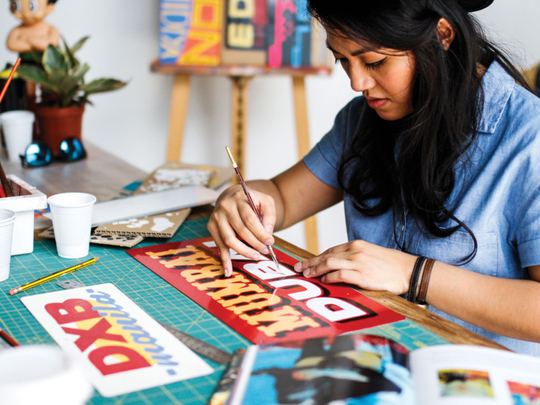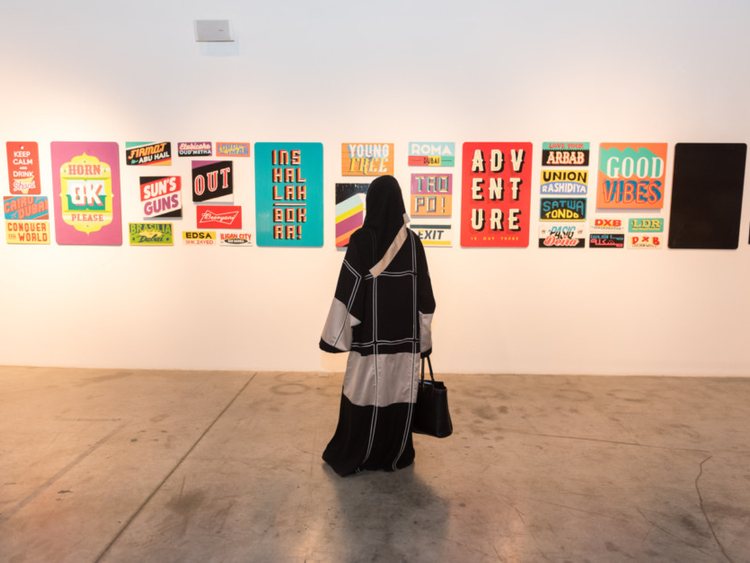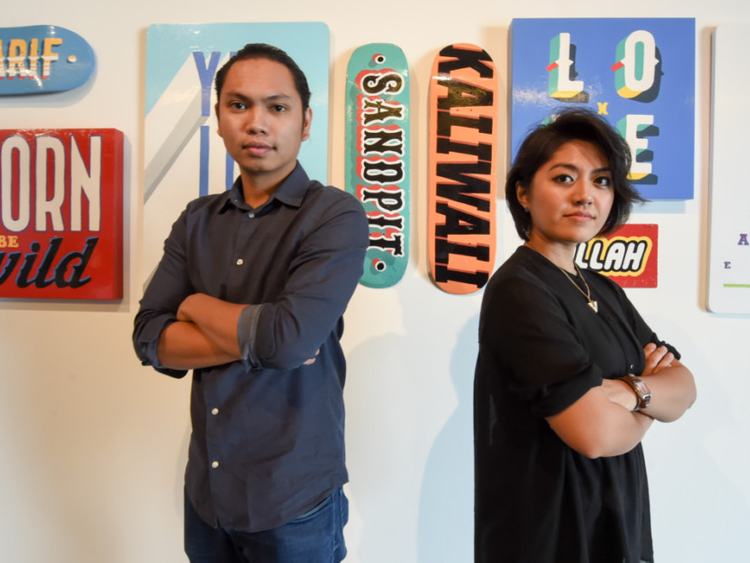
In today’s digital landscape, people are more aware of typography, design and how the world looks around them than ever before. Among a generation that has grown up with computers there are a few who are seeking to engage with the physical processes that go into producing letter forms. Yet many, including type designers, don’t fully know the value and scope of a certain typography in design. Now a team of young graphic designers and artists in Dubai is finding some answers in the tradition behind handpainted signs. In fact, this effort led to an art show titled “Byahe” — made entirely in Dubai — dedicated to the dying art of handpainted type.
The typefaces on display in “Byahe” were inspired by the handpainted lettering found on Jeepneys, a typical transportation vehicle in the Philippines. Artists Rollan Rodriguez, Mary Hechanova and Jude Valderrama examined how people connect through their stories, their travels and experiences. This typographic exhibition of a different kind was launched as part of the annual Dubai Design Week on October 24, and is on show at FN Design at Alserkal Avenue. “Byahe”, tailor-made to debut at this event, served the purpose of bridging local inspirations on a global platform.
Signage art
The core inspiration for Byahe (Tagalog for travel) stems from a fascination with the iconic handpainted signage found on vehicles in the Philippines. The show involved Dubai residents who hail from various cities, with the artworks connecting them to their hometown through the nostalgic handpainted signage — often the most vital mode of communication on the road. The team behind this group is upholding another relevant socio-economically phenomenon of continuous travel and migration.
The artworks were created using enamel on metal plates. The exhibition manually explored the culture and the craft of handpainted lettering, an art that’s often overlooked and is slowly dying. It balances the tricky art of communicating information effectively while demonstrating its core values. On an art gallery’s walls, this creates an opportunity to look at what may seem ordinary with the renewed perspective of unlimited freedom of expression.
“We wanted to explore this dying art and its connection to our own personal histories — a lot of us here in Dubai came from somewhere, and a lot of us are also moving about from place to place,” says Rodriguez, founder and creative director of Ape Creative.
Handpainted lettering is similar to calligraphy. It is an art form that requires hours of practice and a lot of patience. It is not enough to know how letters are structured and the different strokes needed to create various letters. What’s also needed is an understanding of how eye-popping colours can be used and their symbolic representation, especially on road signage.
Three artists from the Philippines came up with the idea of displaying in Dubai their passion for the dying art of handpainted signage. Thus Byahe was born — a very colourful project that acts as a shoutout to a bygone era. It explores the concept of typography with handpainted artworks found in many countries, especially in eastern Europe and Africa. And the Dubai-based design studio Ape Creative has attempted to put the spotlight on the art of signage.
“Art is beyond age and time. The ways of creation might change with time but the meaning and the message remain the same. ‘Byahe’ is about the tradition of signage which has been a part of our societies long before digital technology overshadowed most of our life and space,” says Shaikha Wafa Hasher Al Maktoum, founder of FN Design. “‘Byahe’ brings alive the craft of sign painters that dominated the streets back then. The show let the viewers peep into the history and explore connections with cultures across the world.”
Apart from the names of various countries and cities, popular phrases used in the UAE — such as “kaliwali”, “yallah go”, “ma baarif”, “my friend” — connected viewers to the art on display. “You can find inspiration from anything as long as you’re observant enough to appreciate the beauty in all things,” says Valderrama, who dreams of redesigning DC comics someday.
“Byahe” aims to detach visitors from the world of fast-paced instant consumption of digital technology and reconnect them to an authenticity rooted in history, heritage and a sense of place. The show also brought a fresh perspective to the Philippine culture through its art and design while finding a connection with other cultures of the world.
Hand-drawn
“Sketching has always been a natural part of the creative process since the old masters. It plays a crucial part in our creative process as it helps get our ideas out in an organic, fluid way. Our process begins with research on our selected topic, brainstorming and ideation. We then bring it on to the digital platform and design on the computer,” says Hechanova whose design icons are Rob Clarke, Aaron Draplin, Gemma O’Brien, David Carson, Paul Rand and Saul Bass.
“We used to have traditional painting subjects, but since I started working it’s all digital. So we wanted to take this chance to bring back the old ways of design, which is handpainting,” says Valderrama, who is rather fond of handpainted number plates all over Dubai.
The team of artists says this event has the potential to ring in a new trend. “We wanted to take out these unique elements from our own backyard and see how these signs would speak to people from various parts of the world, from various backgrounds and points of view,” says Rodriguez.
Coming from a generation that designed with digital tools straight away, these artists are pushing the boundaries of contemporary digital art which is changing at an incredible pace. “Yes, especially with the internet this can influence your work easily. But at Ape studio we want to make sure that our works are organic, and not just the fancy stuff you see on the internet,” says Valderrama who finds infinite inspiration everywhere.
He says living and working in Dubai as a graphic designer is a great opportunity for a type artist. “It’s a privilege to travel and explore other cultures while you’re still young. I just took the chance to see what’s going to happen. So far it’s been amazing. In terms of type design, I can say that it has similarities, especially the type designs you see in Satwa. It’s so raw and organic. I think that’s a big part of Dubai’s culture,” he says.
“We see ourselves continually pushing creative boundaries here and witnessing design become a crucial part of the city’s development,” says Hechanova.
For the Ape team, it was mostly about childhood nostalgia. “Handpainted signage in the Philippines is mainly what got us interested in this craft. On the streets of various neighbourhoods in the Philippines, it was commonplace to find ‘mangleletras’ (sign painters) working, so an appreciation for the craft started from an early age. Currently, we draw our inspiration of type from a wide range of designers working digitally and manually with murals as well.
“We were looking for a commercial object that was iconically Filipino, and the first thing that came to mind was the Jeepney. Byahe means ‘travel, trip, or journey’, connecting its relevance to people residing in the UAE, where a majority of the population is expats or en route some journey, sharing their cultures and learning about the culture of the UAE,” says Hechanova.
After “Byahe”, there is more coming on an “epic scale”. It will have something the audience can engage with, says the team. One can hope for a set of projects that deliver happy energy, giving people the opportunity to interact and take them on magical journeys that develop their minds and spirit via art.
Team Ape also has some valuable message for aspiring artists. “Stories live on for generations. Don’t stop telling them through your creative work,” says Hechanova.
Valderrama is certain that executing ideas without wasting time on contemplation is necessary. “Enough of thinking. Start doing,” he says.
And Rodrigues believes in making the most of the creative demand without losing focus. “Capitalise on the idea and the agenda.”
A short documentary by Dubai-based filmmaker Kamil Roxas is also part of the exhibit. The film takes a peek at the artists’ creative processes as well as highlights responses from some travellers who were given signage that refer to their journeys to the UAE.
About Ape
Ape Creative is a graphic design studio based in Dubai. Founded in 2014 by Rollan Rodriguez, Ape’s main focus is transforming ideas into communicative graphics, specialising in brand identity, illustration, art direction and event curation. Their work is highly-characterised by geometry, colour and direct typography. The studio has done creative projects for various established companies such as Al Ghurair Centre, Al Qasba, Capsule Arts, Nandos, Monaqi, Red Bull, Bates Pan Gulf, La Hacienda, Red Bull, Chowking, Dolphin Creative, Al Hadaf, JWT Dubai, Tonic International, Memac Ogilvy and Partnership.
Archana R.D. aka B’lu is an artist-journalist based in the UAE who writes on global art and culture.
“Byahe: A Typographic Exploration” is on show at the Alserkal Avenue in Dubai until January 1, 2017.















